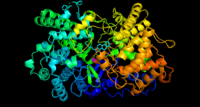
Photo from wikipedia
Abstract In the wild cruciferous wintercress (Barbarea vulgaris), β-amyrin-derived saponins are involved in resistance against insect herbivores like the major agricultural pest diamondback moth (Plutella xylostella). Enzymes belonging to the… Click to show full abstract
Abstract In the wild cruciferous wintercress (Barbarea vulgaris), β-amyrin-derived saponins are involved in resistance against insect herbivores like the major agricultural pest diamondback moth (Plutella xylostella). Enzymes belonging to the 2,3-oxidosqualene cyclase family have been identified and characterized in B. vulgaris G-type and P-type plants that differ in their natural habitat, insect resistance and saponin content. Both G-type and P-type plants possess highly similar 2,3-oxidosqualene cyclase enzymes that mainly produce β-amyrin (Barbarea vulgaris Lupeol synthase 5 G-Type; BvLUP5-G) or α-amyrin (Barbarea vulgaris Lupeol synthase 5 P-Type; BvLUP5-P), respectively. Despite the difference in product formation, the two BvLUP5 enzymes are 98% identical at the amino acid level. This provides a unique opportunity to investigate determinants of product formation, using the B. vulgaris 2,3-oxidosqualene cyclase enzymes as a model for studying amino acid residues that determine differences in product formation. In this study, we identified two amino acid residues at position 121 and 735 that are responsible for the dominant changes in generated product ratios of β-amyrin and α-amyrin in both BvLUP5 enzymes. These amino acid residues have not previously been highlighted as directly involved in 2,3-oxidosqualene cyclase product specificity. Our results highlight the functional diversity and promiscuity of 2,3-oxidosqualene cyclase enzymes. These enzymes serve as important mediators of metabolic plasticity throughout plant evolution.
Journal Title: Plant Physiology
Year Published: 2021
Link to full text (if available)
Share on Social Media: Sign Up to like & get
recommendations!